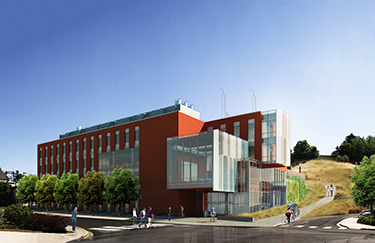|
Subscribe / Renew |
|
|
Contact Us |
|
| ► Subscribe to our Free Weekly Newsletter | |
| home | Welcome, sign in or click here to subscribe. | login |
Construction
| |
 |
November 21, 2013
Design build cuts costs for WSU research lab
Skanska USA

Harrison
|
Statistics continue to show that college graduates often have better job prospects, and that there is a correlation between higher learning and higher earning.
While there may be a debate about the need for more opportunities for high school graduates in the American job market, the trends have led to a significant increase in college enrollment over the past decade.
For universities, this means more than making sure there is space on campus for students. It also means competing for the best students. To do so, the best facilities are needed, from academic spaces like labs to campus dining options and other student amenities.
Of course, that leads to construction. As a contractor, we’re well-accustomed to working with neighbors in the communities where we work by keeping them in the loop on what to expect. On a university campus, where the student experience is such a vital part of college life, it is imperative for construction to cause as few disruptions as possible.
Fortunately, we’re seeing some of the institutions in Washington’s university system start to turn to construction-delivery methods that align with their goals better than the traditional design-bid-build model. This is especially notable at a time when every dollar of public spending is under scrutiny. Fortunately, these construction methods can also deliver the best value to universities.
A functional showpiece
A tremendous example is about to get under way at Washington State University. Together, with LMN Architects and other members of the project team, we’re preparing to deliver the new Clean Technology Laboratory Building. This interdisciplinary facility will boost the state’s high-demand research and education priorities in “clean technology”: the developing industries in renewable materials and the environment.
The building itself will be a facility that will not only help attract top students, but also top researchers throughout the country. Spaces within the building are set up for collaboration, including open, flexible spaces that can work for classes, study sessions or even as event space.
Lounge spaces, as well as finishes that you’d find in class-A office space, enhance the overall experience inside the building. This facility is meant to be a functional showpiece, designed and built to last for generations on campus, even as needs evolve.
In the past, an architect would be retained by the school, designs agreed upon and then handed to the selected contractor to execute. That system often led to conflicts regarding designs and how to execute them, putting all parties at a disadvantage as they scramble to build lines of communication, slowing the entire delivery process.
For universities, that situation is far from ideal. For instance, you cannot recruit leading professors to a campus building that may not be finished on time. Students tire of active construction in “their” space.
Design-build advantages
For the clean-tech building, WSU is utilizing design-build and it will make a significant difference for their project, helping head off some of the traditional construction trouble spots. By working together as one team, the contractor, architect and key engineering partners can identify constructibility issues in the design well before they become an issue in the field.
This means fewer uh-oh moments where a contractor has to tell an architect and a client that the design they each love needs adjustment. Instead, we are working together to make sure everyone is on the same page before a shovel ever hits the ground.
It’s easy to see how working this way has the potential to speed up the schedule. It also gives everyone from the board of trustees to taxpayers peace of mind that they are getting the best value for their dollars.
When the schedule of a project is accelerated, it can save money. When procurement can happen earlier in the process, the best prices for materials can be secured. When planning means fewer surprises, it’s an all-around win.
All of this comes while delivering a project at the same high quality — the difference is a shorter term of disruption on campus and more efficiency.
Moreover, the design-build approach — or even the general contractor/construction manager method — not only brings more people to the table, the collaboration can help promote changes in the way spaces are created.
Architects and contractors build all manner of things. For universities that need to emphasize flexibility in their buildings, ideas for how to create such spaces can be inspired from all sorts of past experiences. Bringing more parties to the table early and approaching the process as a team can help identify creative solutions.
Alternative delivery methods have been put to use at the University of Washington as well. The GC/CM method was used to deliver the renovation of the Husky Union Building last year. That project required a significant amount of preservation of the original building. Additionally, by bringing more parties to the table to plan, we were able to minimize campus disruption while the project was under way. GC/CM also allowed us to significantly increase the efficiency of delivery.
What can work at the UW and WSU can work in other places. All universities should consider the value of alternative delivery methods and see how they can be put to use for the benefit of their campus communities. This is especially true of public institutions at a time when funding is as tight as ever.
Schools, contractors, architects and other stakeholders all stand to gain from the right kind of construction-related collaboration.
Dave Harrison is a senior vice president and account manager for Skanska USA in Seattle.
Other Stories:
- UW builds new dorms to entice students to live on campus
- Wine center will support a growing state industry
- UW: Top 10 capital projects
- A home away from home for Native American students
- WSU: Top 10 capital projects
- Rainier Vista bridge fulfills a long-held vision for UW campus
- A visitor center for the Facebook generation
- Apartment rehab will give students more ways to get social
- Library overhaul was fast, cheap and efficient



